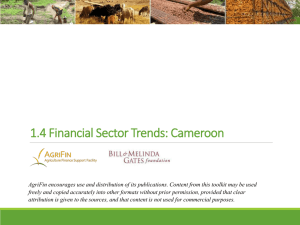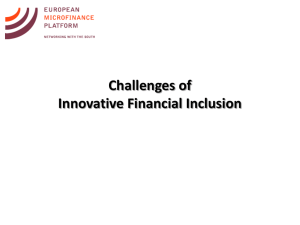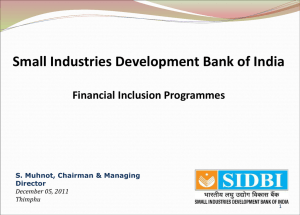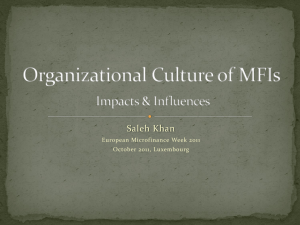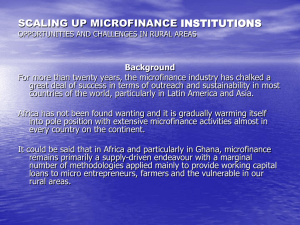P K Saha - SIDBI - Sa-Dhan
advertisement
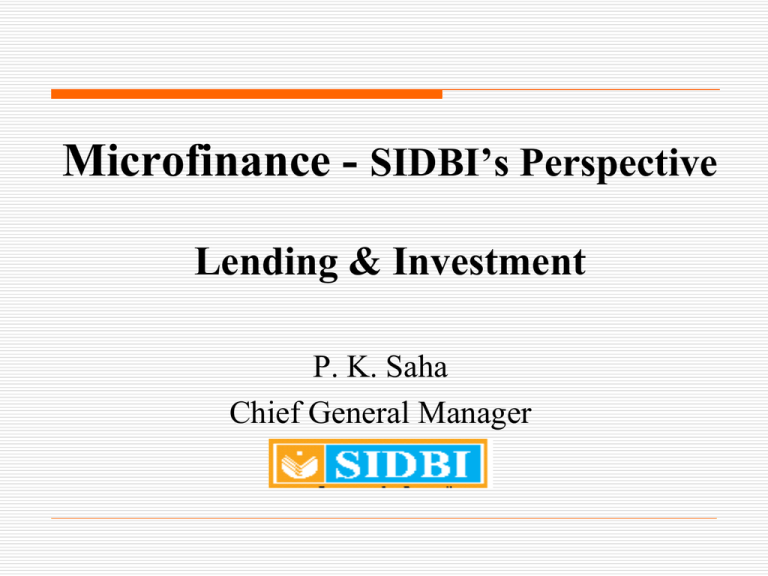
Microfinance - SIDBI’s Perspective Lending & Investment P. K. Saha Chief General Manager Nurturing of MFIs 1994: SIDBI launched its microfinance programme on pilot basis to tap the huge potential of unmet demand for credit in unorganized and informal sector serve its mandate for promoting, financing and developing the micro, small and medium enterprises in India 1999: Upscaling and re-orientation of microfinance programme of SIDBI. SIDBI Foundation for Micro Credit (SFMC), a specialized deptt. set up to create a national network of strong, viable and sustainable Micro Finance Institutions (MFIs) from the informal and formal financial sector. Strategy of SIDBI Utilise existing grassroot institutions for channelising credit Institution building of MFIs Build access and capacity at grassroot level, instead of focusing on subsidies Provide customized financial assistance and capacity building support Encourage investment in microfinance by formal financial sector Strategy of SIDBI Shift towards commercial sources of microfinance Nurture and equip financial intermediaries to deliver quality micro finance services Scientific appraisal, instead of collateral – based lending Build favourable policy and regulatory framework to facilitate orderly growth Features of MCS: Core product of SFMC Focus on poor, mainly women Customised need based package of loan, grant and equity to partner MFIs Capacity building of beneficiaries, MFIs and sector/ training institutions Capacity Assessment Rating (CAR) and Capacity Building Need Assessment (CBNA) prior to sanction Market driven flexible approach for credit delivery with focus on financial sustainability Products of SIDBI Products Direct loan support: Term loan to partner MFIs Quasi-equity type support: Transformation Loan product Credit plus support: Capacity building support Growth Phase Modified products to match up the growing needs of the sector. Corpus Support for Transformation (CST), a new product developed specifically for small grassroot NGOs operating in underserved areas. Risk Fund for wholesaler MFIs to encourage operations in underserved regions. Loan Syndication Microenterprise promotion Portfolio Risk Fund Growth Phase Equity Funding - SIDBI Growth Fund for MFIs (Corpus of Rs.50 crore) set up to equity investment in well-managed corporate MFIs, in the form of quasi-equity / mezzanine finance in medium rung non-corporate / start-up institutions resource support to Private Equity (PE) funds for equity investments in Indian MFIs Corpus increased to Rs. 500 crore Specialized Microfinance branches at 7 locations Pre-requisites for SIDBI while lending Acceptable rating grade Satisfactory credit opinion Adequate capitalization Compliance with AML, KYC, defaulter’s list Quality of Audited financials Good portfolio quality Number of lenders Good track record of promoters Professional management Pre-requisites for SIDBI while investing in equity Pre-requisites for lending Legal form Quality of other investors Realistic projected financials Exit options Good growth potential SIDBI stake < 20 % Profitability Attractiveness of valuation Concerns Transparent and fair practices – Credit discipline Fair practices at field level Competition / multiple financing / client overlap Information sharing Governance and Ownership Issues Boards not diversified Ownership (?) in case of MFIs having PE investors 11 Concerns Transaction costs – Cost-effective delivery Leveraging technology Capital -intensive – grant funds required in initial stages Regulation Conducive policy environment needed given the present size and scale MF Bill yet to be enacted Self-regulation 12 Concerns Capital Adequacy Low level, for the sector at large Improvement in case of larger MFIs Mid-scale MFIs still capital deficient Need to have quasi-equity funding Regional / balanced growth 13 Thank You

